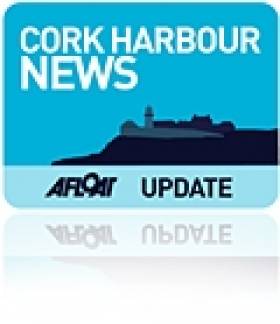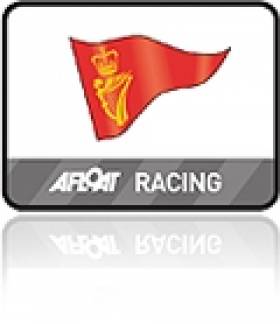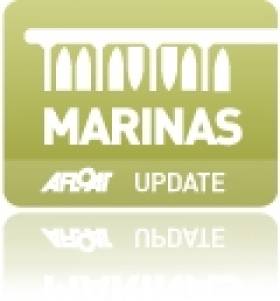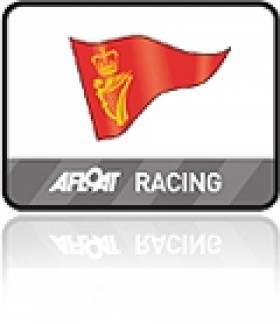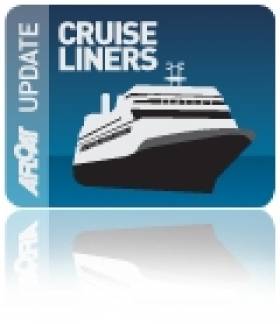Displaying items by tag: Cork Harbour
Cove Salute Media Couple for 'Contribution to Sailing'
#CORKSAILING – Cove Sailing Club's annual prizegiving hosted by Commodore Derry Allister was held with a certain vibrancy at the weekend. Members are buoyed up with the news that its new Junior section at Whitepoint has recruited 152 members, a great boost to sailing in Cork Harbour. The Cobh club is pressing ahead too on its own marina plans, another big area of progress for marine leisure berthing in the harbour.
Earlier this year Cove Sailing Club was granted full planning permission for a 74 berth marina (including visitor berths) at Whitepoint. The proposal being developed is that Cove Sailing Club shall develop and manage the marina in order to provide facilities for use by club members and visitors to Cove.
This year's laying up supper was held at the Commodore Hotel in the seaside town. Members met in the downstairs bar before heading for the Jack Doyle room for lay-up dinner and prizegiving.
There were plenty of annual prize winners from the season of club events (SEE PHOTOS BELOW). Sailing Correspondent and Photographer Claire and Bob Bateman of this Parish received special mention for their work in promoting sailing in the harbour.
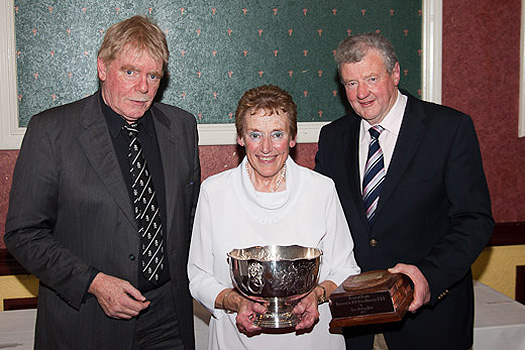
Cove Sailing Club Commodore Derry Allister (left) presents Sailing Journalist's Claire and Bob Bateman with the Foley Rose Bowl
The Bateman's were presented with the Foley Rose Bowl trophy. The trophy was first presented to Cove Sailing Club in 1974 when the late Bryan Foley was Chairman of the Cork Harbour Commissioners. It has many illustrious names on it and is awarded on merit, to the class, club, boat, person or group who have in the opinion of Cove Sailing Club contributed significantly to the promotion of sailing in Cork Harbour.
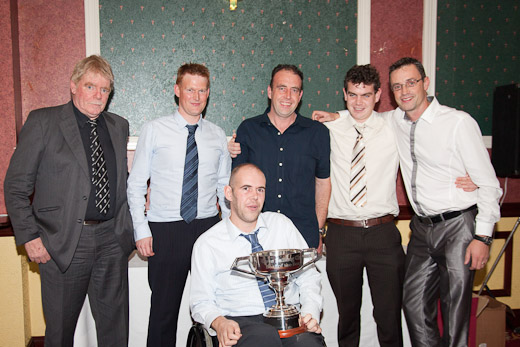
Boat of the year No Half Measures - Finbarr Dorgan (with trophy) and with Derry Allister crew (L-R)Kieran and Gareth Dorgan, Hal Courtney andRichard Marshall. They also won the overall Friday Night League for Kites IRC division.
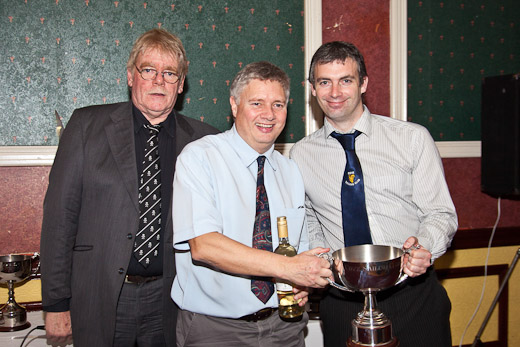
Damian Aherne, skipper of Re Eile being presented with the September league IRC trophy for class 3. Derry and Brendan Ryan (Sailing Secretary) in
background
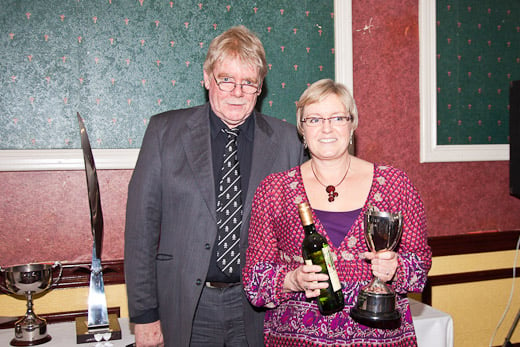
Ann Aherne being presented with the September League Echo trophy for class 3
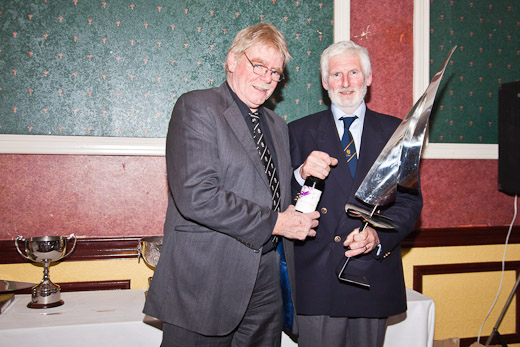
John Doyle, Chanteuse presented with the Friday Night League Whitesail trophy

Dave Marshall and Rob Scandrett receiving the Ballinacurra Cup

Club Person of the year Brendan Ryan (Sailing Secretary)
Crosbie's 'No Excuse' Awarded Royal Cork's Boat of the Year Prize
#ROYAL CORK YACHT CLUB – A leading Munster sailing figure has been deservedly recognised for his contribution to sailing.
Ted Crosbie with his Neils Jeppesen-designed X-yacht 'No Excuse' was awarded the Royal Cork Yacht Club's 'Boat of the Year' trophy at the recent Crosshaven prizegiving.

Former Club Admiral Ted Crosbie lifts RCYC's Boat of the Year Award for 2011. Photo: Bob Bateman
Cork Laser Sailors Win in Grafham and Dun Laoghaire
In the Radial Class, Séafra Guilfoyle was fourth in a fleet of 120 boats and the winner of the Under 16 section. Dermot Lyden finished 74th in his first international event in this class.
At the National Yacht Club on Dublin Bay, another Royal Cork helm Patrick Crosbie won the National 4.7 Squad Trials in a fleet of over 20 boats. Following Patrick were Ross O'Sullivan and Sorcha Ní Shuilleabháin from Kinsale Yacht Club making it 1-2-3 for the Munster club.
Chinese Gybes at CH Marine League (Photos Here!)
#ROYALCORK – With a brisk south easterly breeze blowing the CH Marine winter sailing fleet at Royal Cork Yacht Club was combined into an all in start using course 93 which was shortened after two rounds making for an eight mile course writes Claire Bateman. Photos By Bob Bateman Below. This consisted of a beat to No. 3 back to cage then to No. 12, a beat back to Corkbeg and a reach back to cage.
For the second round they had a run to No. 8, a beat out to No. 3, a run to No. 5 and a finish at cage. There were many thrills and spills during the day with a number of retirements. First out of the block and first to arrive at No. 3 was Anthony O'Leary's 1720 . For what was possibly the first time the four O' Learys, Anthony, Peter, Nin and Robert were sailing together competitively in the same boat with the fifth crew member being Ed Callanan, a grandson of Joe Fitzgerald.
While it was a grey November day nevertheless it was very pleasant because it was very mild for the time of year and racing such as this shortens the winter for the crews. Luckily for the sailors the tides did not affect them very much until towards the end of the race when the spring tides began to exert their force. Silk Breeze, Outrigger, Aramis and Running Wild all retired for one reason or another with a Chinese gybe in one case but all in all the day provided plenty of exhilarating racing with satisfied sailors coming ashore with many exciting experiences to recount.
Royal Cork Yacht Club Seeks Cork Week Administrator
#JOBS – Royal Cork Yacht Club (RCYC) is recruiting an Administrator on a fixed term contract for its Cork Week 2012 regatta.
Cork Week, a major biennial event, the next hosting of which will take place from the 7th July 2012 - 13th July 2012.
Reporting to the Club Manager, RCYC says the role is an exciting opportunity for a person with proven administrative and organisational skills.
The person appointed will have a high level of computer literacy, a knowledge of website management and a familiarity with the world of sailing. The person must be able to demonstrate strong interpersonal abilities and use of initiative in dealing with Members, event competitors, sponsors, suppliers and the general public.Please send application and CV (by email only) to [email protected]
Closing Date for receipt of applications is 25th November, 2011
Restructured Fastnet Line Reduce Year Round Service to Seasonal Schedule
The discontinued winter sailing schedule for this year is also expected not to be repeated during October 2012-March 2013. Fastnet Line's decision to make the Celtic Sea route into a shoulder season and summer only service follows a similar path taken by Stena Line which withdrew Dun Laoghaire-Holyhead (HSS) sailings in mid-September, for report click here. The central corridor route is due to reopen sometime in April or May 2012.
Cork City and County council and Kerry County council have provided €700,000 to support Fastnet Line and yesterday they announced an additional €150,000 in co-funding for the period of the examinership. In order to stabilise finances the ferry company are to radically reduce passenger capacity of the Julia (see photo) from 1,500 down to 950. This is in line with the capacities of the Julia serving 'night' sailings.
She has a crew predominately from Eastern Europe and Irish and UK deck officers. The Bermuda flagged, Hamilton registered vessel is currently berthed at Ringaskiddy Ferry Terminal, Cork Harbour. At 154m she is the largest ferry to date capable of berthing in the limited confines of the swing basin in Swansea and with a draft of 5.8m in a port which is subject to a large tidal range on the Bristol Channel.
Operating costs on the 10 hour service has been severely hampered by continuing increases to world oil prices. From the year 2010 to this year, fuel costs rose by 27% and almost 50% from the original budget of 2009. The company claims that each crossing amounts to €18,560 alone in fuel costs.
Fastnet Line to date has carried 150,000 customers, of which 75% have originated from the UK market, generating on average €350 per person (€40m approx) exclusive of fare and on-board spend. This crucial market is core to the success of the company's direct 'gateway' route to scenic south-west Ireland, with Swansea connected to the M4 motorway linking midland population centres and London. The operator claims a saving of 600km driving based on a round trip compared to using rival ferries running on routes to Rosslare from Pembroke Dock and Fishguard.
Since the reinstatement of the service in March 2010, after Swansea Cork Ferries pulled the Superferry (photo) off-service in 2006, the loss to tourism generated revenue on both sides of the Celtic Sea was estimated to be £25m per annum according to the Welsh Assembly and a similar figure recorded in the Cork and Kerry region.
The company also outlines the reduction in carbon emissions saved from operating the only direct service specifically connecting the regions of Glamorgan and Munster. Some 500,000 freight miles alone were saved in the Welsh region since the service started instead of using alternative route running from Pembrokeshire ports.
- Cork Harbour
- west cork
- port of Cork
- Celtic sea
- Cork City council
- Fastnet Line
- M.V. Julia
- M4 motorway
- Kerry
- Irish High Court
- Stena Line
- Ports and Shipping News
- cork harbour news
- Ferry news
- HSS
- Welsh Assembly
- Cork County Council
- Associated British Ports
- ABP
- Ringaskiddy Ferry Terminal
- M.V. Superferry
- SwanseaCork Ferries
- SCF
- Fastnet Line Group
- Kerry County Council
- HSS Dun LaoghaireHolyhead sailings
- Glamorgan
- Munster regions
- Bristol Channel
- Bristol Channel tidal range
- Swansea Port
- Irish tourism sector
- Pembroke DockRosslare
- FishguardRosslare
New Marina for Cork to Create 32 Full Time Jobs
#JOBS – Cork County Council have issued a notice of intention to grant planning permission to allow the expansion of Cork Harbour Marina, Monkstown to a larger and more comprehensive 285 fingered berth marina as reported previously on Afloat.ie. The expansion will allow for 175 car parking spaces, a marina pavillion building to incorporate a provisions shop, cafe/bar/restaurant, chandlery, marine and boat sales office, Gym, changing rooms with showers, toilets and laundry facilities. All 285 berths are fully serviced, secure fingered berths ranging in size of up to 18m in length, a reception berth, a fuelling berth with diesel and petrol available and a pump out facility berth. The car park and pavillion will be encompassed by a public promenade with seating, panoramic viewing platform, viewing deck promontory and a nature awareness garden.

An artist's impression of plans for an expanded marina at Monkstown
This expansion will lead to one of Ireland's finest marinas facilities which will support up to 90 jobs both directly and indirectly, of these 32 will be full time permanent jobs on the completed Marina complex. The Marina is a unique development, destined to be the South of Ireland's first Blue Flag marina with world-class facilities for berth holders and visitors alike which will allow Cork to capture a bigger slice of the world marine leisure market worth approx €928 billion annually. Initially, set up to address the deficit of safe berths in the Monkstown Bay area the facility is a credit to the Irish team that invested, designed and built it, and of their ambitious plans for its expansion to a five star facility to rival any that Europe has to offer.
A €1.5 million investment into the Irish economy was required to complete the first phase, namely an 82 berth state of the art floating concrete marina. Project co-coordinator James O'Brien advised that "having secured a grant from SECAD (South and East Cork Area Development) and private investment, Monkstown Bay Marina Company proceeded with the totally Irish construction project. All local contractors were employed, from engineering to carpentry to provision of water supplies, to mooring and anchoring specialist teams".
When questioned if he felt that it was wise to undertake such a project during a recession, Mr O'Brien felt that the project will actually help Cork recover from the recession, "In recent years, the lack of marina and berthing facilities in Cork Harbour, the second biggest natural Harbour in the world has been recognised as having a negative impact on the amount of yachts and marine leisure holidaymakers visiting the harbour, and utilising onshore facilities, both in the in the immediate locality and Cork County". Located just 7kms from Ringaskiddy Ferry Port, with access to the UK several times a week and Roscoff in France once a week. A weekly service to Spain is also under negotation, at this time making Cork Harbour Marina the ideal place to winter a visiting boat or to place it in Ireland for multiple family visits, and with the world class cruising grounds of West Cork.
Having a slip (or berth) at a marina offers convenience, security, services, amenities, and a social atmosphere to enjoy. There are broader quality of life benefits for users also, such as improved safety, to-and-from access, and the availability of other essential services, such as electricity to effect repairs, fuel at a convenient marina location, or provisions, parts or repairs being delivered directly to any boat as necessary. Berth spaces are currently available to rent long and short term, at competitive costs.
The boating public have eagerly awaited the new marina for many years, and the response has been one of huge endorsement and positivity, with rapid take-up of berths, and a high incidence of short stay and overnighting too, all bringing much needed tourism revenue to a village that most, up to now, would have sailed or motored past!
Cork Harbour Marina offers an asset-backed; Bord Failte approved BES scheme, in one of the only tax shelters left available to the Irish investor. Full details of this BES scheme are available on request. Berths are allocated on a first come first served basis, all enquiries regarding berthing space should be directed to James O'Brien on 087 3669009
Monkstown is an attractive seaside village that offers visitors beautiful walks in a stunning location - even walking the marina, visitors can enjoy this tranquil and picturesque harbour setting.
South of the city, the marina is also served by a regular bus route, No 223, allowing easy access to Cork City's shopping and social scenes, one of the top cities in the world for a short break, according to a recent Trailfinder survey. Cork Harbour Marina is also only 2kms from the Cross River Ferry, giving easy access to Great Island and East Cork.
For those choosing to stay for an extended period, various ancillary services can be organised - provisioning, refuelling, cleaning, antifouling, boat maintenance and repairs, sail repair, and winter storage both outdoor and covered. The marina team can also organise a boat delivery or recovery service provided by competent Offshore Yacht masters.
Cork Harbour marina is the closest marina to the suburbs of Douglas, Rochestown and Passage West, nestles right in front of the stunning Monkstown village, is convenient to Monkstown Sailing, Rowing, Golf and Tennis Clubs, and the world renowned Bosun Restaurant and Guesthouse, the convivial Monkstown Inn, and the proposed Monkstown Amenity Park, which the local communities are pushing toward completion.
In brief, Cork Harbour Marina is Ireland's newest coastal marina with all year round berthage. The marina itself can accommodate boats up to 17m and consists of an outer perimeter of floating concrete break waters with fingered berths contained internally.
View Larger Map
Creidne Sail Training Scheme
The Naval Service's Sailing Training Vessel Creidne cuts a great pose sailing in Cork Harbour on page three of the Autumn issue of Afloat. The refurbished 47-footer is now in full use by the Naval Service as a training vessel for naval personnel and is consequently a common sight sailing off the Haulbowline base.
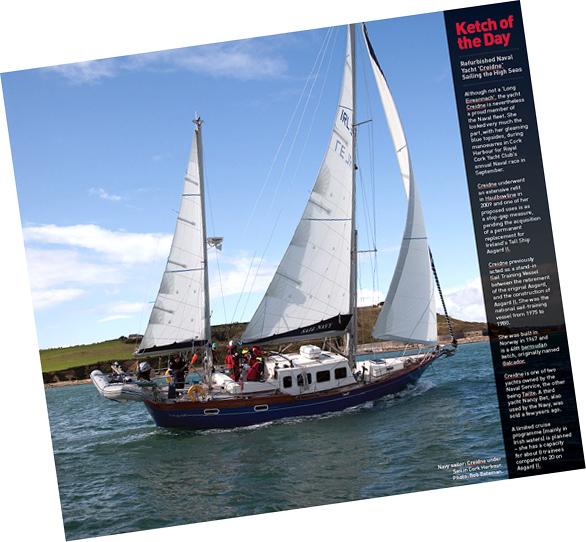
No Sail Training Programme because of Government cut backs
Although Creidne, built in 1967, undertook a limited sail training cruise programme in 2009, the programme was shelved when Creidne became a casualty of the Government's decision to discontinue the Sail Training Scheme operated by Coiste an Asgard. The Defence Forces have asked us to point out that the sail training programme, that took up to eight trainees, has been stopped even if the Autumn Afloat article may have given the impression that the Creidne is still carrying out this function. Apologies for any confusion.
Bandit Steals the Show in Royal Cork Autumn League
Whitesail 1 and Whitesail 2 together with Classes 3 and 4 were sailing in the harbour today and after a somewhat quiet start the wind built from the south south west during the day and remained steady throughout racing in the O'Flynn Exhams sponsored league. With the enthusiasm there is now for whitesail 1 and whitesail 2 and the consistent increasing of numbers in these classes it is obvious they are going to have a major part to play in future events. In Class 4 it was interesting to see Michael Murphy's Shelly D taking first in IRC on the day as it is something he always maintained couldn't be done. In Class 3 the rivalry between the Dorgan family's No Half Measures and Ian Travers' Bandit was renewed, Bandit getting the better of the Dorgans on the day.

Although Afloat's photographer Bob Bateman was not on the rsce course today he flew over it on a separate assignment in the area and managed a brief bird's eye view of the racing.
Outside the harbour midway between the Harp Mark and Roche's Point Pascal Healy's committee boat was on station with Race Officer Richard Leonard and they were half way through the sequence when the wind shifted and there was a postponement while they altered the course. Here the wind was building during the day to between 18 to 20 knots causing some of the yachts to change to number 2 headsails.

At the time of prize giving Yanks $ fFrancs and No Excuse were in the protest room so that result has been held over until next week.
It has been confirmed that last week John Downing's Samba lost portion of her rudder and it appears likely she will miss the remainder of the series. That's tough at this stage but, as miracles do sometime happen, perhaps he may be lucky and get back in time. All will be known tomorrow when she will be lifted out for inspection.

In IRC 0 Jump Juice with Conor Phelan on helm got the better of Kieran and Brian Twomey's Gloves Off while the in the 1720 extremely competitive class Brian Hassett's Dark Side got the better of Denis Murphy's Aquatack and in IRC 1 David Scott's unstoppable EOS got the better of Martin Darrer's True Penance.
Dublin Port Turn-Around Offers Direct Cruises to the Sun
With a short-turn around in port, more cruise-goers will be boarding for a mid-afternoon departure, marking the start of a 13-night Canary Islands & Madeira cruise. When she heads out of the port, the first port of call is Falmouth then it's off to Leixoes (Portugal), Agadir (Morocco), Arrecife (Lanzarote), Las Palmas (Gran Canaria), Funchal (Madeira), Lisbon (Portugal) and Vigo (Spain) before returning to Dublin.
The vessels final end-of season cruise from Dublin is on 25 October, with a 10-night cruise to Nice (returning by air). The interim ports of call are to Falmouth, Leixoes, Lisbon, Cartagena (Spain) Palma and Mahon (Menorca). To read more about this cruise click HERE.
In addition to Dublin calls the former Cunard Countess, also called this season to Cork Harbour. It was during a call last month to Ringaskiddy that another 'Cunarder' the flagship, Queen Mary 2 was also in port on a call to Cobh. To read more of that visit click HERE.


























